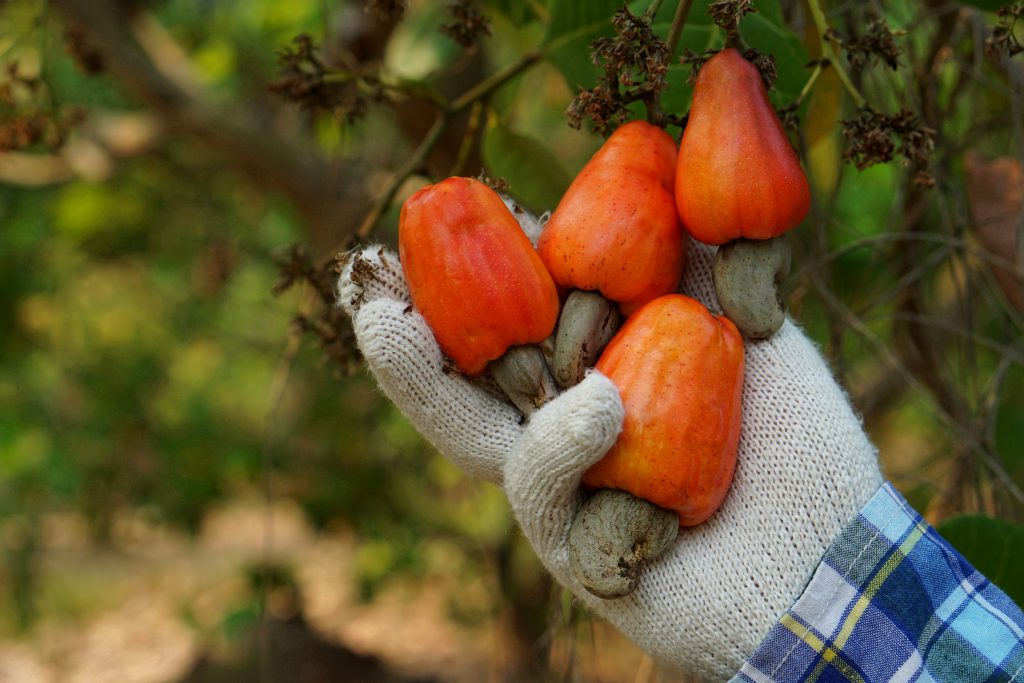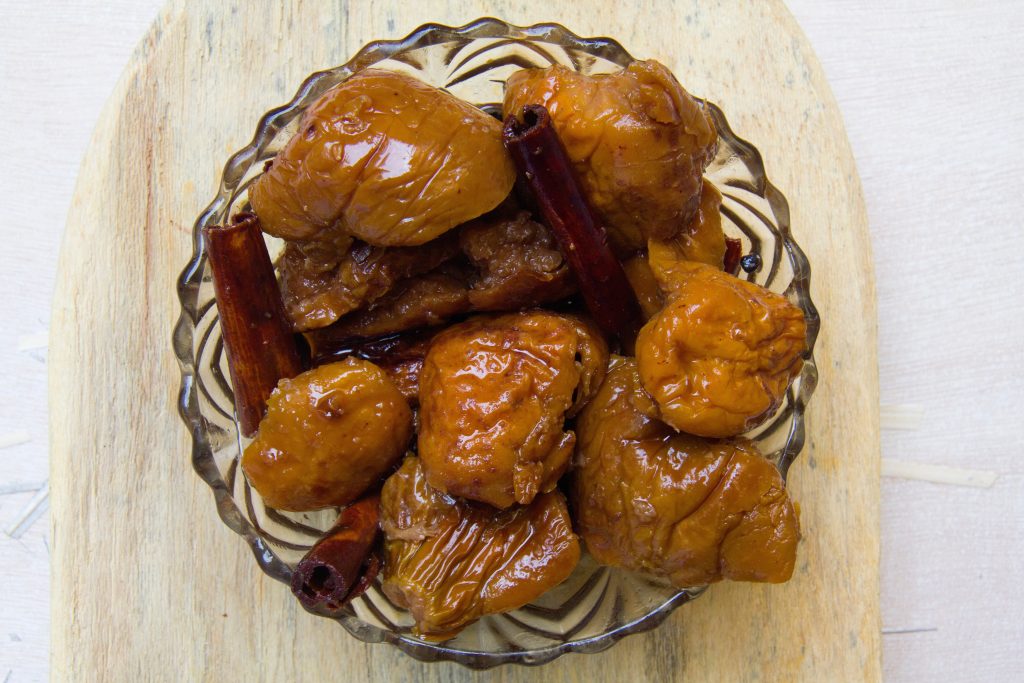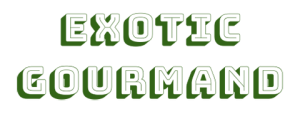A cashew apple is a unique fruit growing from the same flower that produces the cashew nut. It's a yellowish or red fruit with a distinct flavor akin to a combination of bell pepper, cucumber, strawberry, and mango.
Table of Contents
What is a Cashew Apple?
A cashew apple (Anacardium occidentale) is the accessory fruit produced by an evergreen tree in the Anacardiaceae (cashew) family.
It also goes by various common names depending on the cultivation region; these include:
- Marañón in Central America
- Caju, Pomme de Cajou, or Cajueiro in Portugal
- Merey in Venezuela
- Jambu Monyet or Jambu Monet in Indonesia and Malaysia
- Anacardier or Acajou in France
- Mamuang or Himmalphan in Thailand
The cashew apple is a fleshy, light red or yellow pear-shaped fruit measuring 2 to 4.25 inches (5-10.75 cm) long. It develops from the pedicel (floral part) of the cashew flower.
The cashew apple is considered an accessory, pseudo, or false fruit since it contains no seed. Instead, it has a fleshy, spongy, and aqueous yellow flesh with chewy, stringy fibers.
The true fruit of the cashew tree is the cashew seed, commonly known as the cashew nut (although it’s not a typical nut). The cashew seed is a kidney-shaped drupe that looks like a boxing glove. It develops earlier than the cashew apple from the receptacle and contains one seed.
The cashew seed is the most popular part of the cashew nut tree, mainly eaten as a snack or used for culinary purposes. It’s enclosed in a double-shelled case containing a phenolic liquid called anacardic acid.
The cashew apple has a fruity, vegetal, and nutty flavor but with an astringent aftertaste.
The History of Cashew Apples
Cashew apples are native to Brazil in South America. They’ve grown wildly in Northeastern Brazil, between the Atlantic coastline and Amazon Basin, since ancient times.
Cashew apples first spread to Venezuela, on the northern coast of South Africa. Later in the 16th century, Portuguese traders introduced the fruit to Goa in India and Mozambique. The cashew trees were initially planted in these regions to prevent soil erosion, but they were later used for food and beverage production.
The fruit later spread to other regions in Asia (mainly Southeastern Asia), northern Australia, and Africa. It’s also believed that the Spanish introduced cashew apples in Central America and the Caribbean.
Cashew apples were later imported to Florida from India in the 20th century. The cashew trees are now grown in home gardens and botanical collections in Florida and Hawaii (but not for commercial use).
For decades, cashew apples have been used to make a prized alcoholic drink called Feni in Goa, India. Portuguese Monks introduced this process in the 18th century after spotting an opportunity from discarded cashew apple fruits. Feni has been used to relieve coughs, colds, and flu-like symptoms in India since then.
In Brazil, cashew apple juice was used in traditional medicine to treat chronic dysentery and sore throat.

What Does a Cashew Apple Taste Like?
A cashew apple has a fruity, nutty flavor with an astringent aftertaste and some tropical notes similar to mangoes. Some people find it unpalatable, but this flavor makes it ideal for making alcoholic drinks.
Raw cashew apples are popular snacks in Cambodia, Africa, and some parts of Asia. The fruits are cut into pieces and eaten with some added salt.
Cashew apples are also blended and mixed with honey (or other sweeteners) to make cashew apple juice, and they’re fermented and distilled into liquor.
When cooked, cashew apples are less astringent, making them excellent additives in sweet and savory dishes. They’re also boiled, steamed, simmered, or cooked into jams, chutney, preserves, and desserts.
How to Tell When A Cashew Apple is Ripe
Here are some tips to help you know when a cashew apple is ripe and safe for eating:
| Color | When ripe, mature cashew fruits turn from green to yellow, pink, or red. And the cashew seed becomes grey. |
| Scent | Ripe cashew apples have a distinctively sweet, fruity aroma with spicy nuances. |
| Firmness | The cashew seed becomes hard when the cashew fruit ripens. |
| Dropping | When ripe, the cashew apple and nut drop to the ground. |
How Many Cashews Are In A Cashew Apple?
Each cashew apple fruit has one nut (or cashew seed). The nut develops earlier and hangs below the cashew apple. It’s fondly known as a cashew nut and has many culinary applications.
However, one must take special precautions when preparing the nuts for consumption due to the yellowish-red oily liquid produced by the shell. This viscous liquid irritates the skin and may cause dermatitis, so it’s best to wear gloves when removing the nut from the cashew apple.
Cashew nuts are featured in many South Asian and African cuisines. For instance, whole cashew nuts are used in South Asia to garnish curries and sweets. They’re also crushed into a paste to form the base for curries.
In India, cashew nuts are ground or roasted to make sweets and desserts. They’re also roasted and salted in Indonesia and eaten as snacks called kacang mete.
In the Philippines, the nuts make a popular accompaniment to rice cake (suman), a delicacy in the province of Antipolo.
Cashew nuts make cashew milk an alternative to dairy milk in several African countries. Powdered cashew nuts and mashed potatoes make a delicious Mozambican cake called bolo plan.
Cooking with Cashew Apples
Like cashew nuts, cashew apples have a wide range of culinary applications. But before we get to that, here’s how to prepare cashew apples before cooking:
- After picking the fruits, remove the seeds from each cash apple while wearing gloves.
- Wash the cashew apples well under running water.
- Cut the fruits into smaller pieces (or wedges).
Your cashew apples are now ready for cooking.
Blend them into juice, or ferment them to make liquor. You can also use them to make juice, preserves, chutney, or syrup. Cooked cashew apples make great additions to baked goodies and savory dishes.

Here are specific recipes featuring cashew apples:
Cashew Apple Jam (Dulce De Cajuil): A traditional Dominican delicacy, this dessert is a must-have for picnics and road trips. It requires a few ingredients, including cashew apples, water, granulated sugar, cinnamon, and cloves.
Stewed Cashew Apples: This easy-to-make Brazilian dish uses the same ingredients as the Dominican apple jam. But the cooking method is slightly different, and you must add lemon or lime juice to get the desired flavor.
Goan Cashew Apple Cake: A traditional delicacy in Goa (India), this yummy cake will tease your palette. It’s made using cashew apples, parboiled rice, coconut, palm jaggery, ghee, sugar, and salt.
Cashew Fruit Payasam: Here’s another Indian dish featuring cashew apples. The dessert requires only a few ingredients, including cashew apples, jaggery, coconut, and cardamom.
How to Store Cashew Apples
Ripe cashew apples are highly perishable, as they are often infested by fungi and yeast. So, it would be best to consume or use ripe cashew apples collected from the ground immediately or within 24 hours.
For cashew apples picked from the tree while still unripe, keep them on your counter (at room temperature) until they ripen. You should refrigerate them immediately after ripening to extend their shelf life. Cashew apples can also be chilled in airtight polythene bags for weeks.
Alternatively, candy your cashew apples into syrup and preserve them in airtight jars. You can also dry the fruit in the sun or use an electric dryer to extend its shelf life.
Nutritional Benefits of Cashew Apples
Cashew apples are nutrient-dense fruits containing vitamins, minerals, carbohydrates, fiber, and other bioactive compounds.
Here’s the nutritional composition of cashew apples and related health benefits:
Vitamin C: This antioxidant protects the body’s cells from destructive free radicals. It also supports healthy skin and boosts the immune system.
Potassium: Helps regulate blood pressure and improve heart health and muscle function.
Magnesium: This is important for muscle, nerve, and cell functions. The mineral also regulates mood and blood glucose levels.
Calcium: Promotes healthy bones and teeth. It also promotes heart, muscle, and nerve functions.
Phosphorus: Helps to maintain and repair cells and tissues. It also supports the growth, development, and production of genetic material (DNA and RNA).
Iron: Supports the production of red blood cells. It’s also essential in growth and development.
B Vitamins (riboflavin and thiamine): Riboflavin (B2) has antioxidant and anti-inflammatory properties. So it helps prevent oxidative stress and the inflammation of nerves. Thiamine (B1) improves immunity and helps the body deal with stressful conditions.
Carotenoids are antioxidants that reduce the risk of certain cancers and eye diseases.
Phenolic compounds (tannins and flavonoids): Have antioxidant, anti-inflammatory, and anti-aging properties. They boost the immune system and promote wound healing.
Fiber: Improves digestion and regulates blood glucose levels.
Carbohydrates (fructose and glucose): These are essential sources of energy to fuel body organs.
Where to Purchase Cashew Apples
Although cashew apples are available all year round in tropical regions where they are cultivated. It’s rare to find fresh cashew fruit in non-native areas because they’re easily bruised and highly perishable.
However, you can buy frozen or dried cashew apples from specialty fruit markets or online retailers. Alternatively, purchase cashew apples processed into juiced pulp, fruit preserves, or jam.

